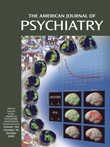Cosegregation of Bipolar Disorder and Autosomal-Dominant Medullary Cystic Kidney Disease in a Large Family
Abstract
OBJECTIVE: The authors report a large family in which bipolar disorder appears to cosegregate with autosomal-dominant medullary cystic kidney disease. METHOD: Information regarding diagnostic criteria for bipolar disorder and medullary cystic kidney disease were gathered from family members through formal research interviews, hospital admission records, imaging reports, and laboratory data. RESULTS: Of the seven members with medullary cystic kidney disease, five had bipolar I disorder, one had unipolar depression, and one had a hyperthymic phenotype. Information was not available on two members. CONCLUSIONS: The cosegregation in this family suggests a close proximity between genes for the two disorders. The two known loci of medullary cystic kidney disease are in regions of chromosomes 1 and 16 that have been previously linked to bipolar disorder and schizophrenia. This family may be a useful resource for positional cloning of bipolar candidate genes.



